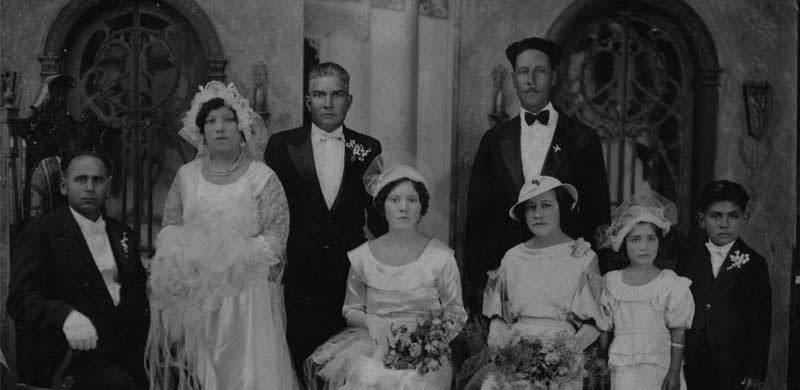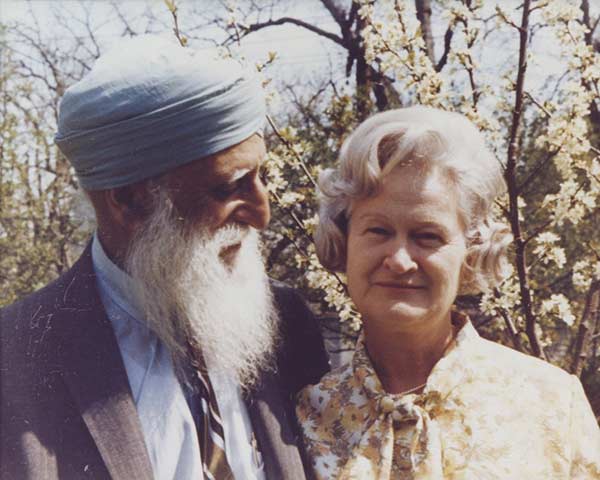
It was in early 1980s when I was driving through Yuba City with a couple of friends. It was lunch time and we were looking for a halal restaurant when we spotted Rasul's. At the restaurant we met a man who introduced himself as Mohammad Ali Rasul. He spoke in Mexican accented English but he told us his father came from the Punjab region now in Pakistan and his mother was of Mexican ancestry. There were 400 such marriages between Punjabi men and Mexican women by 1940, according to Professor Karen Leonard of UC Irvine. Rasul gave us a warm welcome when we told him we were also originally from Pakistan. He offered us his "roti quesadilla" special without charge, as a gift. I had forgotten all about it until memory was refreshed by a story titled "California’s Lost (and Found) Punjabi-Mexican Cuisine" by Sonia Chopra I read on Eater.com.
Early South Asians:

Currently, there are nearly 4 million people from Bangladesh, India, Pakistan and other South Asian nations in the United States. The earliest record of South Asians arriving in California is in the San Francisco Chronicle of April 6, 1899. It carried a story of the arrival of four Sikh men who were allowed to enter the United States in San Francisco, according to UC Davis Digital Archives.
Karen Leonard, a professor of anthropology at the University of California at Irvine and author of "Making Ethnic Choices: California’s Punjabi Mexican Americans", says that there were almost 2,000 Punjabi men living in California in the early 1900s, and approximately one-third of them married (or re-married) after settling in the state. Over 80% of the men were Sikh and most of the rest were Muslim. Almost all of them were from Central Punjab and came to California by ships from the then British Hong Kong via Vancouver in British Columbia in Canada. They had a choice between going to canal colonies of Lyallpur (now Faisalabad, Pakistan) and emigrating to North America. Most moved to canal colonies while the rest chose to go to the United States.
Punjabi Farmers:
While some Punjabis worked on building the transcontinental railroad along with Chinese immigrants, the vast majority of them chose farm work. California reminded them of their home in the Punjab, the land of five rivers. One of them described the similarity in the following words as narrated by Professor Karen Leonard:
"In my story of the Land of Five Rivers was Sacramento Valley. The river Sutlej was Feather River. The rest of the four rivers – American, Bear, Yuba, and Sacramento. My Bhaskhra (Dam), the Oroville Dam. Mu Govind Sagar, the Oroville Lake. The city of Anandpur Sahib, the nearby town of Paradise. The Shivaliks, the Sierra Foothills. There was Naina Devi, our Mount Shasta. And yes, the Ja-walamukhi, the Lassen Volcanic Park. Obviously, I was carried away by my imagination. Yet, the reality was not far behind. The water, like the water in the Punjab, had the same urge to run downward. The distant hills had the same charm. The fire in Ja-walamukhi and in the Lassen Volcano has the same way to burn."
United States v. Bhagat Singh Thind:
South Asians, like their fellow Asians among the Chinese and the Japanese, faced widespread discrimination in the United States culminating in the Immigration Act of 1917. It was the second act, also known as the Literacy Act or the Asiatic Barred Zone Act after the Chinese Exclusion Act of 1882, aimed squarely at restricting immigration. An even stricter version of the US immigration law was passed in 1924 which was praised by Adolf Hitler in Mein Kampf, according to Daniel Okrent, author of The Guarded Gate: Bigotry, Eugenics and the Law That Kept Two Generations of Jews, Italians and Other European Immigrants Out of America.

Bhagat Singh Thind, a US Army veteran and a naturalized US citizen, was stripped of his citizenship under the Immigration Act of 1917. He sued to get his status restored. In a landmark case United States v. Bhagat Singh Thind, Thind argued that as a descendent of Indian Aryans he was racially "white". The US Supreme Court unanimously rejected Thind's argument and ruled that he was not white "in accordance with the understanding of the common man".
Post-1965 Immigration:
The population of South Asians in America remained very low due to severe immigration restrictions from non-European countries until the US Immigration Act of 1965, also known as the Hart-Celler Act. This act opened up immigration from Asia, Africa and Latin America and significantly changed the US demographics in the last half century.
Most of 4 million South Asians in the United States today owe their presence in this country to the passage of this 1965 law passed by Democrats. A large number of South Asians are engineers and technologists and many live in Silicon Valley. Over 450,000 Pakistani immigrants and their children live in the United States as of 2013, according to a report compiled by Migration Policy Institute. Of these, 273,000 were born in Pakistan and the remaining 180,000 are US-born. Pakistani-American population has more than doubled in the last decade due to increased immigration, according to US Census data. Pakistani-Americans (pop: 450,000) are the seventh largest community among Asian-Americans, behind Chinese (3.8 million), Filipinos (3.4 million), Indians (3.2 million), Vietnamese (1.74 million), Koreans (1.7 million) and Japanese (1.3 million), according to Asian-American Center For Advancing Justice. They are still a minuscule fraction of the overall US population.
Trump's Anti-Immigration Policies:
The demographic changes since 1965 have angered many Republican white Americans who support immigration restrictions and voted for President Donald Trump in 2016 general election. Trump has called Mexicans "criminals and rapists", complained about letting in people from "shit-hole" countries and imposed ban on entry of Muslims from several countries. His efforts to further restrict overall immigration have met with significant resistance from Congressional Democrats.
Early South Asians:

Currently, there are nearly 4 million people from Bangladesh, India, Pakistan and other South Asian nations in the United States. The earliest record of South Asians arriving in California is in the San Francisco Chronicle of April 6, 1899. It carried a story of the arrival of four Sikh men who were allowed to enter the United States in San Francisco, according to UC Davis Digital Archives.
Karen Leonard, a professor of anthropology at the University of California at Irvine and author of "Making Ethnic Choices: California’s Punjabi Mexican Americans", says that there were almost 2,000 Punjabi men living in California in the early 1900s, and approximately one-third of them married (or re-married) after settling in the state. Over 80% of the men were Sikh and most of the rest were Muslim. Almost all of them were from Central Punjab and came to California by ships from the then British Hong Kong via Vancouver in British Columbia in Canada. They had a choice between going to canal colonies of Lyallpur (now Faisalabad, Pakistan) and emigrating to North America. Most moved to canal colonies while the rest chose to go to the United States.
Punjabi Farmers:
While some Punjabis worked on building the transcontinental railroad along with Chinese immigrants, the vast majority of them chose farm work. California reminded them of their home in the Punjab, the land of five rivers. One of them described the similarity in the following words as narrated by Professor Karen Leonard:
"In my story of the Land of Five Rivers was Sacramento Valley. The river Sutlej was Feather River. The rest of the four rivers – American, Bear, Yuba, and Sacramento. My Bhaskhra (Dam), the Oroville Dam. Mu Govind Sagar, the Oroville Lake. The city of Anandpur Sahib, the nearby town of Paradise. The Shivaliks, the Sierra Foothills. There was Naina Devi, our Mount Shasta. And yes, the Ja-walamukhi, the Lassen Volcanic Park. Obviously, I was carried away by my imagination. Yet, the reality was not far behind. The water, like the water in the Punjab, had the same urge to run downward. The distant hills had the same charm. The fire in Ja-walamukhi and in the Lassen Volcano has the same way to burn."
United States v. Bhagat Singh Thind:
South Asians, like their fellow Asians among the Chinese and the Japanese, faced widespread discrimination in the United States culminating in the Immigration Act of 1917. It was the second act, also known as the Literacy Act or the Asiatic Barred Zone Act after the Chinese Exclusion Act of 1882, aimed squarely at restricting immigration. An even stricter version of the US immigration law was passed in 1924 which was praised by Adolf Hitler in Mein Kampf, according to Daniel Okrent, author of The Guarded Gate: Bigotry, Eugenics and the Law That Kept Two Generations of Jews, Italians and Other European Immigrants Out of America.

Bhagat Singh Thind, a US Army veteran and a naturalized US citizen, was stripped of his citizenship under the Immigration Act of 1917. He sued to get his status restored. In a landmark case United States v. Bhagat Singh Thind, Thind argued that as a descendent of Indian Aryans he was racially "white". The US Supreme Court unanimously rejected Thind's argument and ruled that he was not white "in accordance with the understanding of the common man".
Post-1965 Immigration:
The population of South Asians in America remained very low due to severe immigration restrictions from non-European countries until the US Immigration Act of 1965, also known as the Hart-Celler Act. This act opened up immigration from Asia, Africa and Latin America and significantly changed the US demographics in the last half century.
Most of 4 million South Asians in the United States today owe their presence in this country to the passage of this 1965 law passed by Democrats. A large number of South Asians are engineers and technologists and many live in Silicon Valley. Over 450,000 Pakistani immigrants and their children live in the United States as of 2013, according to a report compiled by Migration Policy Institute. Of these, 273,000 were born in Pakistan and the remaining 180,000 are US-born. Pakistani-American population has more than doubled in the last decade due to increased immigration, according to US Census data. Pakistani-Americans (pop: 450,000) are the seventh largest community among Asian-Americans, behind Chinese (3.8 million), Filipinos (3.4 million), Indians (3.2 million), Vietnamese (1.74 million), Koreans (1.7 million) and Japanese (1.3 million), according to Asian-American Center For Advancing Justice. They are still a minuscule fraction of the overall US population.
Trump's Anti-Immigration Policies:
The demographic changes since 1965 have angered many Republican white Americans who support immigration restrictions and voted for President Donald Trump in 2016 general election. Trump has called Mexicans "criminals and rapists", complained about letting in people from "shit-hole" countries and imposed ban on entry of Muslims from several countries. His efforts to further restrict overall immigration have met with significant resistance from Congressional Democrats.
